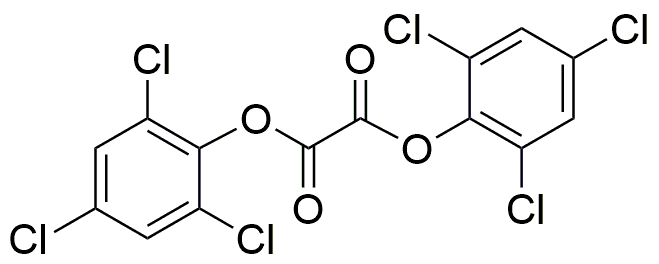Bis(2,4,6-trichlorophenyl) oxalate is widely utilized in research focused on:
- Fluorescent Dyes: This compound is used in the synthesis of fluorescent dyes, which are essential in biological imaging and diagnostics. Its ability to produce bright fluorescence makes it valuable in microscopy and flow cytometry.
- Analytical Chemistry: It serves as a reagent in analytical chemistry for detecting and quantifying various substances. Its high sensitivity allows for accurate measurements in environmental testing and quality control.
- Polymer Chemistry: The compound is employed in the development of polymer materials, particularly in creating high-performance plastics that require thermal stability and chemical resistance.
- Pharmaceuticals: In the pharmaceutical industry, it is used in the synthesis of active pharmaceutical ingredients (APIs), contributing to the formulation of effective medications with specific therapeutic effects.
- Environmental Applications: Its role in the degradation of pollutants makes it useful in environmental remediation efforts, helping to break down harmful chemicals in contaminated sites.
Informations générales
Propriétés
Sécurité et réglementation
Applications
Bis(2,4,6-trichlorophenyl) oxalate is widely utilized in research focused on:
- Fluorescent Dyes: This compound is used in the synthesis of fluorescent dyes, which are essential in biological imaging and diagnostics. Its ability to produce bright fluorescence makes it valuable in microscopy and flow cytometry.
- Analytical Chemistry: It serves as a reagent in analytical chemistry for detecting and quantifying various substances. Its high sensitivity allows for accurate measurements in environmental testing and quality control.
- Polymer Chemistry: The compound is employed in the development of polymer materials, particularly in creating high-performance plastics that require thermal stability and chemical resistance.
- Pharmaceuticals: In the pharmaceutical industry, it is used in the synthesis of active pharmaceutical ingredients (APIs), contributing to the formulation of effective medications with specific therapeutic effects.
- Environmental Applications: Its role in the degradation of pollutants makes it useful in environmental remediation efforts, helping to break down harmful chemicals in contaminated sites.
Documents
Fiches de données de sécurité (FDS)
La FDS fournit des informations de sécurité complètes sur la manipulation, le stockage et l’élimination du produit.
Spécifications du produit (PS)
Le PS fournit une description complète des propriétés du produit, notamment sa composition chimique, son état physique, sa pureté et les exigences de stockage. Il détaille également les plages de qualité acceptables et les applications prévues du produit.
Certificats d'analyse (COA)
Recherchez des certificats d'analyse (COA) en saisissant le numéro de lot du produit. Les numéros de lot et de lot se trouvent sur l'étiquette d'un produit, après les mots « Lot » ou « Lot de fabrication ».
Numéro de catalogue
Numéro de lot/série
Certificats d'origine (COO)
Ce certificat d'exploitation confirme le pays dans lequel le produit a été fabriqué, et détaille également les matériaux et composants utilisés et s'il est issu de sources naturelles, synthétiques ou autres sources spécifiques. Ce certificat peut être requis pour les douanes, le commerce et la conformité réglementaire.
Numéro de catalogue
Numéro de lot/série
Fiches de données de sécurité (FDS)
La FDS fournit des informations de sécurité complètes sur la manipulation, le stockage et l’élimination du produit.
DownloadSpécifications du produit (PS)
Le PS fournit une description complète des propriétés du produit, notamment sa composition chimique, son état physique, sa pureté et les exigences de stockage. Il détaille également les plages de qualité acceptables et les applications prévues du produit.
DownloadCertificats d'analyse (COA)
Recherchez des certificats d'analyse (COA) en saisissant le numéro de lot du produit. Les numéros de lot et de lot se trouvent sur l'étiquette d'un produit, après les mots « Lot » ou « Lot de fabrication ».
Numéro de catalogue
Numéro de lot/série
Certificats d'origine (COO)
Ce certificat d'exploitation confirme le pays dans lequel le produit a été fabriqué, et détaille également les matériaux et composants utilisés et s'il est issu de sources naturelles, synthétiques ou autres sources spécifiques. Ce certificat peut être requis pour les douanes, le commerce et la conformité réglementaire.

